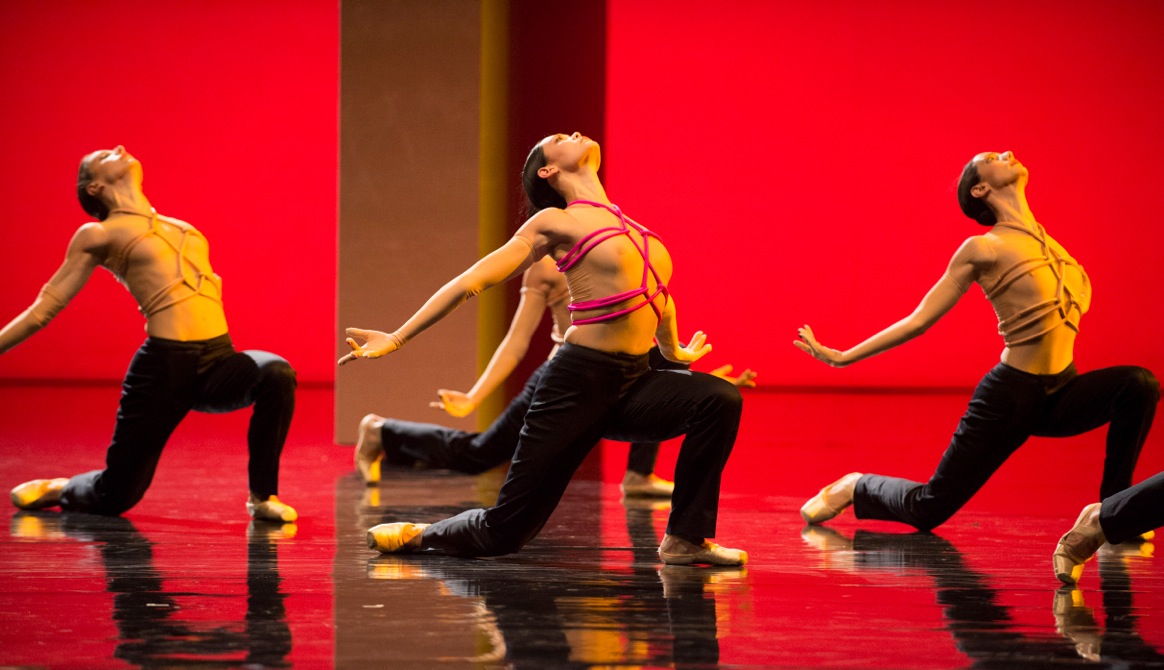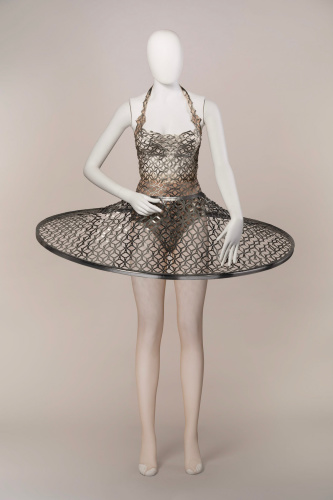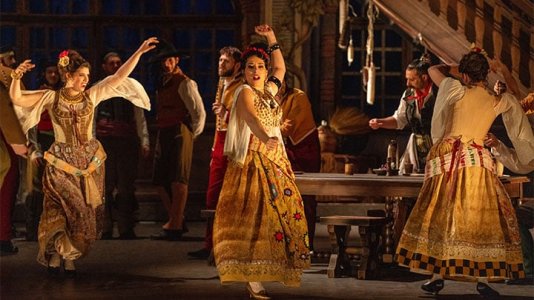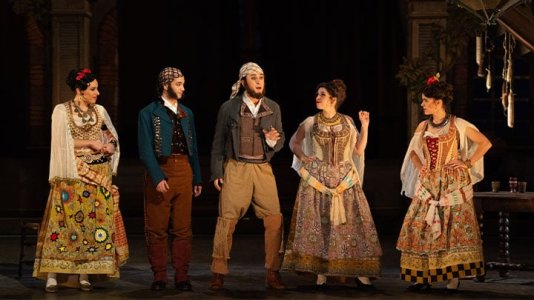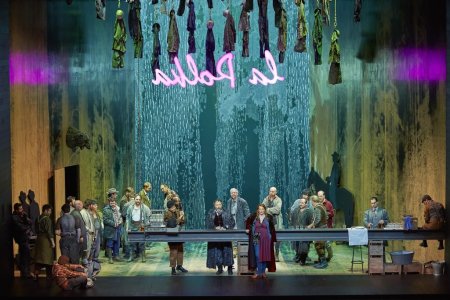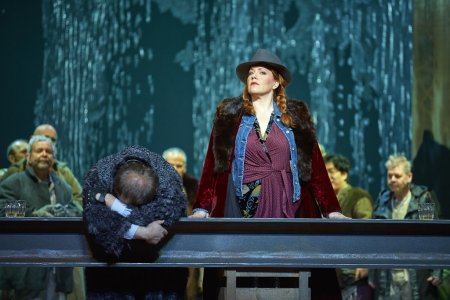-
The Red Carpet Highlights of... The 78th Annual Cannes Film Festival 2025!
-
MODERATOR'S NOTE: Please can all of theFashionSpot's forum members remind themselves of the Forum Rules. Thank you.
You are using an out of date browser. It may not display this or other websites correctly.
You should upgrade or use an alternative browser.
You should upgrade or use an alternative browser.
Designer Costumes for Performing Arts
- Thread starter Benn98
- Start date
Benn98
Well-Known Member
- Joined
- Aug 6, 2014
- Messages
- 42,532
- Reaction score
- 20,627
Stylist Katie Shillingford for Obsidian Tear. Royal Opera House, London, 2016:
The first ballet production ever to be styled as opposed to costumed. Looks are from Craig Green, Hood by Air, Vivienne Westwood, and Assaf Reeb.



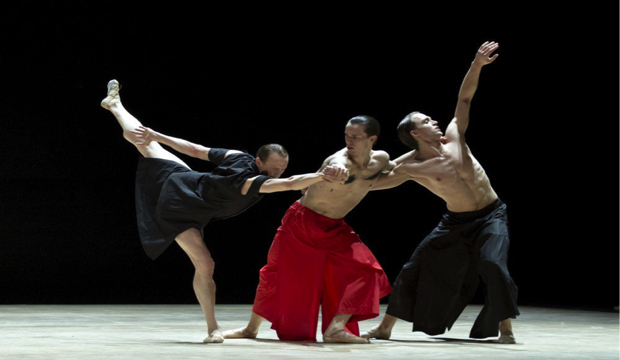





Another Magazine/NY Times/Culture Whisper
The first ballet production ever to be styled as opposed to costumed. Looks are from Craig Green, Hood by Air, Vivienne Westwood, and Assaf Reeb.









Another Magazine/NY Times/Culture Whisper
Benn98
Well-Known Member
- Joined
- Aug 6, 2014
- Messages
- 42,532
- Reaction score
- 20,627
MEET THE MAN HELPING VALENTINO AND IRIS VAN HERPEN DESIGN FOR THE BALLET
written by Aria Darcella September 24, 201
Eight years ago the New York City Ballet went high fashion. The NYCB’s board vice chair, Sarah Jessica Parker, came up with a plan to get notable designers to craft costumes for the shows. The result was the Fall Fashion Gala, a popular program that runs every September, bridging the runway with the world of dance. Now, fans have a chance to see the looks up close. Intersect by Lexus has launched Design in Motion: A New York City Ballet Fall Fashion Gala Retrospective, an exhibit of costumes from the shows. “We’re very excited that this is really the first time to have this collection together all at once,” says Corey Proffitt, communications manager at Lexus. “One of our goals here in the city as a brand space is really to bring cultural experiences to the city and I think we’ve certainly succeeded with this one.”
But the exhibit isn’t just a highlights reel of designer costumes (although names like Valentino, Virgil Abloh, and Alberta Ferretti are sure to attract visitors). It is also a chance for people to appreciate the work of the NYCB’s Costume Shop, which brings the couturier’s ideas to life. Marc Happel, the NYCB’s director of costumes, works closely with the designers to translate their visions to the stage. He gave a private tour of the exhibit to The Daily, and discussed what it has been like to work on the gala since its inception.
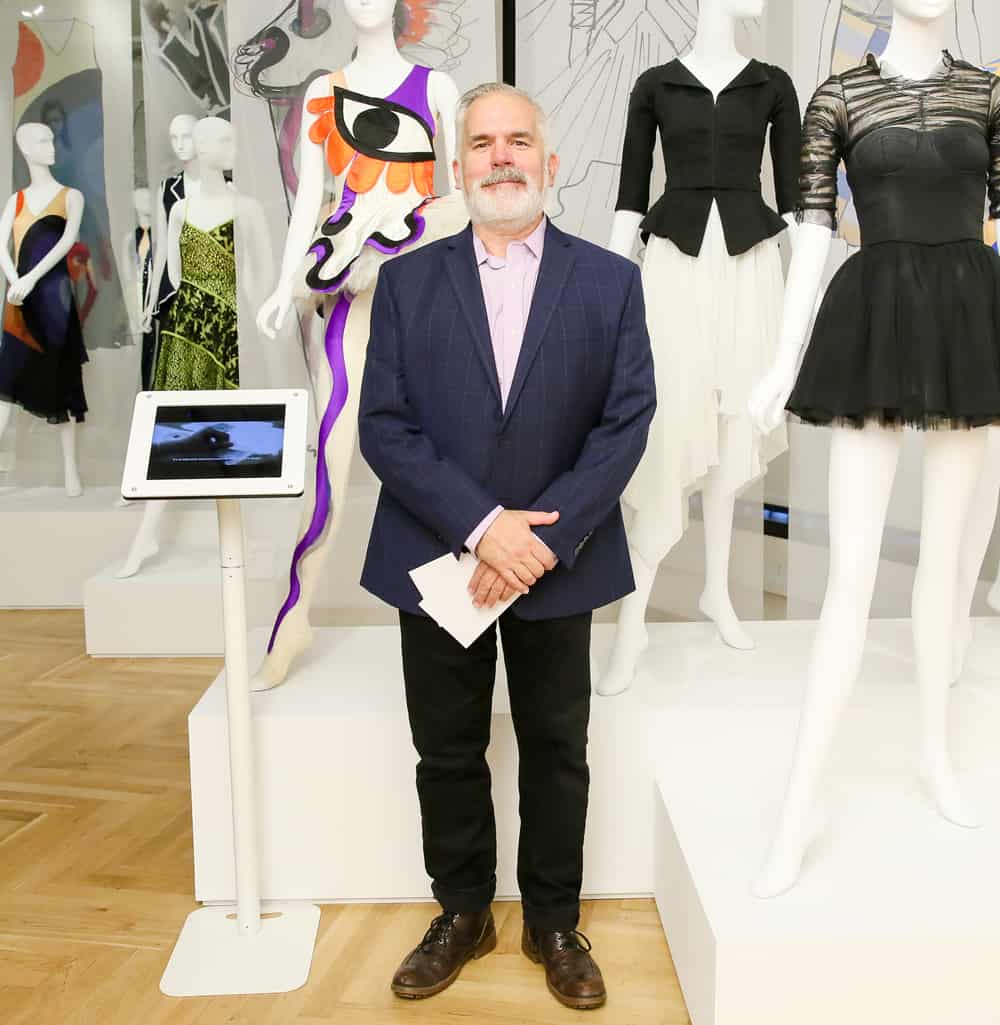
Marc Happel (BFA)
This program kicked off in 2012 with a big name…
The whole concept was it was supposed to be up-and-coming fashion designers. And then we started with Valentino! But he was great. He was amazing. He was so excited and on-board, and always there. Some of it he based on existing things from his couture lines. The one downstairs, for instance, is more or less a replica of a dress of his.
And then in 2013 Iris van Herpen did the plastic dress and boots, which I’ve since seen on display at the Museum at FIT.
The boot was something that Iris was very keen on, as was I. She loved the way it changed the body. I thought that was really exciting. It was met with some negative criticism, but I think it’s very effective, and I think it worked really well and really beautifully.
Have there ever been ideas pitched that were too difficult to achieve?
Not really. We pretty much found a way to make it all [work]. The Iris van Herpen clothes got on stage and suddenly everybody realized they made noise. There was this kind of crackling sound which no one thought was going to happen.
Over the music?
Kind of, yeah! And the choreographer…[at first] the boots drove him crazy but I was so into the boots, as was Iris. And the dancers really loved it, so they made it happen. But that was one of those things where they got on stage and they started the dress rehearsal and there was this crackling sound, and we were just like, “Oh!” But what do you do? Three days before… you don’t start over.
Tell us about the following year.
2014 was a very busy year! Thom Browne was super exciting to have around, and he was so in to it. He was really great because he was always there. Troy Schumacher, the choreographer, wanted this world of school children…
Perfect designer for school-inspired uniforms!
Yeah, I know! He said when he came to the first fitting, “I want them all to look like they’re wearing their older brother’s clothes.” And then we had Sarah Burton for Alexander McQueen, which was of course very exciting. She sent these samples of incredibly complicated embroidery. As always, I’m trying to find ways to do it that’s couture, that can last weeks and weeks and [look like] thousands and thousands of dollars. But we just don’t have that. So I found a company that does computer embroidery, and they did an amazing job of replicating it. You wouldn’t really believe that was all done on a computer.
When designers are coming in with these concepts how do you navigate what can and cannot be done in theater?
I have a hard time saying, “No.” I’ll usually try to find a way. That was a situation where we tried to find a way. Iris’ was another one. That was the first time we moved into the 21st century because we had a computer programmer figure out the pattern for us, put it on a thumb drive, and we printed it out. We’d never done that before.
Do you ever get excited about the designers you work with?
In 2015, I got the amazing Dries van Noten, which was a high, high, high for me. Especially going to Antwerp and going to his studio, being there with him. It was just such a fashion high. He’s amazing. And he was totally into it, totally on-board. He sent over two big crates of their clothes from that season and he wanted us to put them on the two dancers and for me to take videos of them dancing in. Then he based it on that.
If you could work with any designer, who would be on your wish list?
It would be really interesting to have Alessandro Michele to come in. Miuccia Prada would be interesting. If we’re going to go big? Go big! There’s others…ThreeASFOUR would have been interesting too.
Which of the other designer collaborations stand out to you?
Giles Deacon—who did Kyle Abraham’s ballet—was one of the most exciting ones for me we had. It was really interesting how he created this total world like no other. It reminded me of a Kara Walker painting with silhouettes, because they were weird period silhouettes mixed together. And then there was this feather [neck-piece], which our dancer, Peter Walker, wore. I was like, “He’s never going to be able to wear that!” But we put it around his neck in a fitting and he was like, “I’m going to make this work!” And he did, brilliantly. You can see in the video that he really did an amazing job.
Have any of the other fashion-y elements posed as a challenge for dancers?
2018 was Gareth Pugh, which was all about blood, and black, and leather. These red face masks, which the choreographer loved and the dancers at first absolutely hated. But then they got used to them. The girls had a bit of trouble because of their eyelashes. They wear stage eyelashes because they took them off at one point. So that was a little bit of a struggle.
How do these designers get chosen?
In the beginning Sarah Jessica Parker made a list that I gave to the choreographers. Some were very keen on how to deal with it. Justin Peck is very connected to all worlds, so he tapped right in. Some are not so keen, so I would say, “Go to style.com or go to Vogue and look up their runway shows, look at the looks. When you see one that appeals to you, write their name down or put a check next to it.” They would come to me with two or three names and Sarah Jessica would put out an ask, and hopefully they would bite…most of the time they do.
She’s gotten very busy so she’s handed it to me a little more. Our current one that we’re about to go in to is Zac Posen and Anna Sui, and they happen to both be friends of mine. I wanted to make it a really New York-centric gala. They both said yes right away. It’s smaller; it’s very New York. I thought it was very cool that way.
What is the process like when designers come in? How involved do they get?
Some are incredibly involved. Thom Browne was really involved. Valentino was incredibly involved. Some would like to be, but the issue we have is that our fall gala happens in September when [fashion week] is also happening. I often have their assistants pull me aside and say, “Ok, they are not available for these two weeks. You’re going to have to do it on your own.” It’s a lot of photographs sent back and forth with a lot of magic markers making alterations. FaceTime has become our friend for fittings. We manage to make it work.
I notice there aren’t any traditional tutus as one would expect for ballet…
The closest that ever happened was that for some reason Virgil Abloh wanted to do all the women in tutus, but his choreographer did not want tutus at all. She wanted the opposite of that. So we ended up with these little skirts. It was a compromise.
Virgil Abloh’s design, second from right (BFA)
This year you’ll be designing too, yes?
We’re doing Symphony in C, which is a ballet that I re-designed. Peter Martins asked me to re-design a few years ago. Jonathan Stafford has decided for our gala we would do two new ballets and then a classic, which is great. So in this case it’s two new fashion design ballets, and then Symphony in C, which is a really stark, black and white tutu, really sparkly ballet.
Have you become friends with any of these designers like Valentino?
Yeah! Every so often he calls and checks in, or says he’s calling from the boat. And every time he does that I’m like, “Ok, it’s not a boat. I’ve seen pictures of it, it’s a ship.” I always get him to laugh at that. Then he tells me that the deck is so hot the puppy’s paws are burning and I’m just like, “Ok, you have way too much free time.” Iris I’ve stayed friends with. Giles I’ve stayed friends with.
What makes an effective costume?
A costume that a dancer has total mobility in, looks good on stage, and maybe adds a layer of story or character.
Fashionweekdaily
written by Aria Darcella September 24, 201
Eight years ago the New York City Ballet went high fashion. The NYCB’s board vice chair, Sarah Jessica Parker, came up with a plan to get notable designers to craft costumes for the shows. The result was the Fall Fashion Gala, a popular program that runs every September, bridging the runway with the world of dance. Now, fans have a chance to see the looks up close. Intersect by Lexus has launched Design in Motion: A New York City Ballet Fall Fashion Gala Retrospective, an exhibit of costumes from the shows. “We’re very excited that this is really the first time to have this collection together all at once,” says Corey Proffitt, communications manager at Lexus. “One of our goals here in the city as a brand space is really to bring cultural experiences to the city and I think we’ve certainly succeeded with this one.”
But the exhibit isn’t just a highlights reel of designer costumes (although names like Valentino, Virgil Abloh, and Alberta Ferretti are sure to attract visitors). It is also a chance for people to appreciate the work of the NYCB’s Costume Shop, which brings the couturier’s ideas to life. Marc Happel, the NYCB’s director of costumes, works closely with the designers to translate their visions to the stage. He gave a private tour of the exhibit to The Daily, and discussed what it has been like to work on the gala since its inception.

Marc Happel (BFA)
This program kicked off in 2012 with a big name…
The whole concept was it was supposed to be up-and-coming fashion designers. And then we started with Valentino! But he was great. He was amazing. He was so excited and on-board, and always there. Some of it he based on existing things from his couture lines. The one downstairs, for instance, is more or less a replica of a dress of his.
And then in 2013 Iris van Herpen did the plastic dress and boots, which I’ve since seen on display at the Museum at FIT.
The boot was something that Iris was very keen on, as was I. She loved the way it changed the body. I thought that was really exciting. It was met with some negative criticism, but I think it’s very effective, and I think it worked really well and really beautifully.
Have there ever been ideas pitched that were too difficult to achieve?
Not really. We pretty much found a way to make it all [work]. The Iris van Herpen clothes got on stage and suddenly everybody realized they made noise. There was this kind of crackling sound which no one thought was going to happen.
Over the music?
Kind of, yeah! And the choreographer…[at first] the boots drove him crazy but I was so into the boots, as was Iris. And the dancers really loved it, so they made it happen. But that was one of those things where they got on stage and they started the dress rehearsal and there was this crackling sound, and we were just like, “Oh!” But what do you do? Three days before… you don’t start over.
Tell us about the following year.
2014 was a very busy year! Thom Browne was super exciting to have around, and he was so in to it. He was really great because he was always there. Troy Schumacher, the choreographer, wanted this world of school children…
Perfect designer for school-inspired uniforms!
Yeah, I know! He said when he came to the first fitting, “I want them all to look like they’re wearing their older brother’s clothes.” And then we had Sarah Burton for Alexander McQueen, which was of course very exciting. She sent these samples of incredibly complicated embroidery. As always, I’m trying to find ways to do it that’s couture, that can last weeks and weeks and [look like] thousands and thousands of dollars. But we just don’t have that. So I found a company that does computer embroidery, and they did an amazing job of replicating it. You wouldn’t really believe that was all done on a computer.
When designers are coming in with these concepts how do you navigate what can and cannot be done in theater?
I have a hard time saying, “No.” I’ll usually try to find a way. That was a situation where we tried to find a way. Iris’ was another one. That was the first time we moved into the 21st century because we had a computer programmer figure out the pattern for us, put it on a thumb drive, and we printed it out. We’d never done that before.
Do you ever get excited about the designers you work with?
In 2015, I got the amazing Dries van Noten, which was a high, high, high for me. Especially going to Antwerp and going to his studio, being there with him. It was just such a fashion high. He’s amazing. And he was totally into it, totally on-board. He sent over two big crates of their clothes from that season and he wanted us to put them on the two dancers and for me to take videos of them dancing in. Then he based it on that.
If you could work with any designer, who would be on your wish list?
It would be really interesting to have Alessandro Michele to come in. Miuccia Prada would be interesting. If we’re going to go big? Go big! There’s others…ThreeASFOUR would have been interesting too.
Which of the other designer collaborations stand out to you?
Giles Deacon—who did Kyle Abraham’s ballet—was one of the most exciting ones for me we had. It was really interesting how he created this total world like no other. It reminded me of a Kara Walker painting with silhouettes, because they were weird period silhouettes mixed together. And then there was this feather [neck-piece], which our dancer, Peter Walker, wore. I was like, “He’s never going to be able to wear that!” But we put it around his neck in a fitting and he was like, “I’m going to make this work!” And he did, brilliantly. You can see in the video that he really did an amazing job.
Have any of the other fashion-y elements posed as a challenge for dancers?
2018 was Gareth Pugh, which was all about blood, and black, and leather. These red face masks, which the choreographer loved and the dancers at first absolutely hated. But then they got used to them. The girls had a bit of trouble because of their eyelashes. They wear stage eyelashes because they took them off at one point. So that was a little bit of a struggle.
How do these designers get chosen?
In the beginning Sarah Jessica Parker made a list that I gave to the choreographers. Some were very keen on how to deal with it. Justin Peck is very connected to all worlds, so he tapped right in. Some are not so keen, so I would say, “Go to style.com or go to Vogue and look up their runway shows, look at the looks. When you see one that appeals to you, write their name down or put a check next to it.” They would come to me with two or three names and Sarah Jessica would put out an ask, and hopefully they would bite…most of the time they do.
She’s gotten very busy so she’s handed it to me a little more. Our current one that we’re about to go in to is Zac Posen and Anna Sui, and they happen to both be friends of mine. I wanted to make it a really New York-centric gala. They both said yes right away. It’s smaller; it’s very New York. I thought it was very cool that way.
What is the process like when designers come in? How involved do they get?
Some are incredibly involved. Thom Browne was really involved. Valentino was incredibly involved. Some would like to be, but the issue we have is that our fall gala happens in September when [fashion week] is also happening. I often have their assistants pull me aside and say, “Ok, they are not available for these two weeks. You’re going to have to do it on your own.” It’s a lot of photographs sent back and forth with a lot of magic markers making alterations. FaceTime has become our friend for fittings. We manage to make it work.
I notice there aren’t any traditional tutus as one would expect for ballet…
The closest that ever happened was that for some reason Virgil Abloh wanted to do all the women in tutus, but his choreographer did not want tutus at all. She wanted the opposite of that. So we ended up with these little skirts. It was a compromise.
Virgil Abloh’s design, second from right (BFA)
This year you’ll be designing too, yes?
We’re doing Symphony in C, which is a ballet that I re-designed. Peter Martins asked me to re-design a few years ago. Jonathan Stafford has decided for our gala we would do two new ballets and then a classic, which is great. So in this case it’s two new fashion design ballets, and then Symphony in C, which is a really stark, black and white tutu, really sparkly ballet.
Have you become friends with any of these designers like Valentino?
Yeah! Every so often he calls and checks in, or says he’s calling from the boat. And every time he does that I’m like, “Ok, it’s not a boat. I’ve seen pictures of it, it’s a ship.” I always get him to laugh at that. Then he tells me that the deck is so hot the puppy’s paws are burning and I’m just like, “Ok, you have way too much free time.” Iris I’ve stayed friends with. Giles I’ve stayed friends with.
What makes an effective costume?
A costume that a dancer has total mobility in, looks good on stage, and maybe adds a layer of story or character.
Fashionweekdaily
MulletProof
Well-Known Member
- Joined
- Apr 18, 2004
- Messages
- 28,743
- Reaction score
- 7,364
^ want to be mind-blown but I think I've seen CDG in better days and Akhnaten not enough times that I'm just happy her need to make these clothes have at last found the right outlet (stage + opera).
billy45ew5
Member
- Joined
- Nov 18, 2019
- Messages
- 3
- Reaction score
- 0
simply astonishing
Benn98
Well-Known Member
- Joined
- Aug 6, 2014
- Messages
- 42,532
- Reaction score
- 20,627
Couture Creations for Dancing Bodies
An exhibition at the Centre National du Costume de Scène in France considers the dialogue between the stage and the runway.
By Roslyn Sulcas
Jan. 1, 2020
MOULINS, France — Soft jersey bathing suits, molded on the body, fitted pink cloche caps framing the face. These were Coco Chanel’s simple yet revolutionary designs for the Ballets Russes’s “Le Train Bleu” (1924), a dance about gilded youth at the seaside, doing calisthenics and playing tennis and golf.
Chanel was just one of a star-studded artistic team: The scenario was by Cocteau, the front curtain by Picasso, the choreography by Bronislava Nijinska and the score by Darius Milhaud. But in choosing Chanel to design the costumes, Diaghilev, as so often, broke new ground.
“Chanel was the first couturier to create costumes for the stage,” said Philippe Noisette, the curator of “Couturiers de la Danse,” an exhibition that continues through May 3 at the Centre National du Costume de Scène, or National Theatrical Costume Museum, here in the Auvergne region of France. Sportswear, Mr. Noisette noted, was a relatively new category of clothing, and Chanel’s practical, stylish designs both surprised and inspired her audiences in this early crossover moment between ballet and fashion.
One of the bathing outfits from “Le Train Bleu” is on prominent display in “Couturiers de la Danse,” which traces couturier-choreographer collaborations from 1924 to the present. The exhibition is organized by theme: “Shapes,” “Second Skin,” “Not So Classical” and “Materials.”
Iris van Herpen, Rick Owens, Gareth Pugh and Hedi Slimane.
“I’m really interested in the dialogue you often see between stage and runway,” Mr. Noisette said. “The stage can be a kind of laboratory, a sketch pad, for the designer. You sometimes see inventions in costumes that show up in the collections the next year. And sometimes pieces are tested in runway shows and then appear onstage.” He quoted Chanel: “Fashion doesn’t only exist through the clothes; it’s in the air.”
But what looks good on a runway doesn’t necessarily translate directly to the stage. Dance costumes have to conform to the specific needs of the performers, choreography and theater, which even the most sophisticated couturier may have to learn.
“After you have designed a piece, you have to ask, can this be danced in?” said Harriet Jung, who together with her design partner Reid Bartelme specializes in costumes for dance. “If there is a lot of partnering, if they slide on the ground a lot, or are lifted in the air a lot, you have to think about how the fabric will handle it, whether it will be comfortable, flexible and not get in the way or between the dancers.”
Sometimes you learn this the hard way, Ms. Jung said, describing a boned corset, created for the ballerina Julie Kent, that broke into pieces during a rehearsal. (And other times, the designer overrules mere notions of practicality; in some of Walter Van Beirendonck’s designs for the ballet “Sous Apparence,” the dancer “can hardly see out of the eyeholes,” Mr. Noisette said.)
You can learn the fundamentals of clothing construction through study, Mr. Bartelme wrote in an email. But understanding “the mechanics of dance costume is learned through trial and error, and from the shops and makers who have done it before.”
Couturiers who sustain creative relationships with choreographers get a chance to learn those mechanics. Beyond its four themes, the exhibition also has sections devoted to specific choreographer-designer collaborations: Jean-Paul Gaultier and Régine Chopinot; Issey Miyake and William Forsythe; Gianni Versace and Maurice Béjart; and the eclectic design choices of the choreographer Daniel Larrieu.
The exhibition has a decidedly European focus, a choice that was made partly for practical reasons, Mr. Noisette said, though he regretted among other gaps not having any costumes created for the Merce Cunningham Dance Company, especially the remarkable lumpy Rei Kawakubo pieces for “Scenario.”
After a walk through the exhibition, Mr. Noisette talked about some of the costumes — what they reveal about fashion and innovation and how they speak of dance in its time. Here are edited excerpts from that conversation.
Charleston effect
On Aura Tout Vu was created for “L’Enfant et Les Sortilèges” (2016), choreographed by Jeroen Verbruggen for the Monte Carlo Ballet. Jean-Christophe Maillot, the director of that company, has a history of commissioning fashion designers, including lesser-known ones. These designers, who are Bulgarian and Portuguese, “combine a whimsical eccentricity with a real couture finish and detailing,” Mr. Noisette said.
Marie-Agnès Gillot’s “Sous Apparence,” which she created in 2012 for the Paris Opera Ballet. Most of the dancers in the work wear more conventional attire (although, unconventionally, the men were on point); these pieces, Mr. Noisette said, were like interventions in the ballet, “blocks of color and geometric form which suddenly appeared.”
Like tutus, these costumes are made from tulle. But here the fabric is folded and pleated “so that it becomes a carapace,” Noisette said. This one is called the bee. Like the others it has a playful quality: one looks like a tree, another like a surfboard. It is “a bit of a challenge to the spectator,” Mr. Noisette said. “At first the costumes look like pure shape, but when you look at it close up, you see how detailed the work is.”
Silver fish
Benjamin Millepied’s “Clear, Loud, Bright, Forward,” created for the Paris Opera Ballet in 2015, Ms. van Herpen has kept the traditional shape of the costume, but taken away the many layers of tulle that usually make up the skirt; it’s almost an abstract idea of a tutu. “I think it changes the way you look at this traditional female ballet costume,” Mr. Noisette said. “The ballerina is less objectified, in a different space.”
Plastic cowboy
1990 Biennale de la Danse in Lyon, which had “America” as its theme, allowing Ms. Skinazi to riff on cowboy stereotypes with panache. She “likes a very colorful palette,” Mr. Noisette said. “This is obviously a homage to the cowboy tradition, but the trousers are made from PVC and false fur, while the jacket is leather and suede.” He pointed out that couture tends to use pure, expensive fabrics like wool, silk and linen, but Ms. Skinazi mixes in cheaper materials that create great visual impact. “It’s a very sophisticated piece, a kind of disguise, but also really fun.”
dance in her runway shows; this dress suggests that costumes are sometimes born from fashion as well as sometimes inspiring it. Here she uses a traditional style of Romantic-era ballet dress, which also refers to the Dior silhouettes of the late-’40s. Her Paris fashion-week show in September was inspired by Dior’s love of flowers, and here they are layered into the costume. Made out of muslin, they are sewn between layers of mousseline and tulle, both on the bodice and the skirt. “At the beginning, you don’t really see them; they gradually reveal themselves through the movement,” Mr. Noisette said. “There is something very romantic and touching about it.”
New York Times
An exhibition at the Centre National du Costume de Scène in France considers the dialogue between the stage and the runway.
By Roslyn Sulcas
Jan. 1, 2020
MOULINS, France — Soft jersey bathing suits, molded on the body, fitted pink cloche caps framing the face. These were Coco Chanel’s simple yet revolutionary designs for the Ballets Russes’s “Le Train Bleu” (1924), a dance about gilded youth at the seaside, doing calisthenics and playing tennis and golf.
Chanel was just one of a star-studded artistic team: The scenario was by Cocteau, the front curtain by Picasso, the choreography by Bronislava Nijinska and the score by Darius Milhaud. But in choosing Chanel to design the costumes, Diaghilev, as so often, broke new ground.
“Chanel was the first couturier to create costumes for the stage,” said Philippe Noisette, the curator of “Couturiers de la Danse,” an exhibition that continues through May 3 at the Centre National du Costume de Scène, or National Theatrical Costume Museum, here in the Auvergne region of France. Sportswear, Mr. Noisette noted, was a relatively new category of clothing, and Chanel’s practical, stylish designs both surprised and inspired her audiences in this early crossover moment between ballet and fashion.
One of the bathing outfits from “Le Train Bleu” is on prominent display in “Couturiers de la Danse,” which traces couturier-choreographer collaborations from 1924 to the present. The exhibition is organized by theme: “Shapes,” “Second Skin,” “Not So Classical” and “Materials.”
Iris van Herpen, Rick Owens, Gareth Pugh and Hedi Slimane.
“I’m really interested in the dialogue you often see between stage and runway,” Mr. Noisette said. “The stage can be a kind of laboratory, a sketch pad, for the designer. You sometimes see inventions in costumes that show up in the collections the next year. And sometimes pieces are tested in runway shows and then appear onstage.” He quoted Chanel: “Fashion doesn’t only exist through the clothes; it’s in the air.”
But what looks good on a runway doesn’t necessarily translate directly to the stage. Dance costumes have to conform to the specific needs of the performers, choreography and theater, which even the most sophisticated couturier may have to learn.
“After you have designed a piece, you have to ask, can this be danced in?” said Harriet Jung, who together with her design partner Reid Bartelme specializes in costumes for dance. “If there is a lot of partnering, if they slide on the ground a lot, or are lifted in the air a lot, you have to think about how the fabric will handle it, whether it will be comfortable, flexible and not get in the way or between the dancers.”
Sometimes you learn this the hard way, Ms. Jung said, describing a boned corset, created for the ballerina Julie Kent, that broke into pieces during a rehearsal. (And other times, the designer overrules mere notions of practicality; in some of Walter Van Beirendonck’s designs for the ballet “Sous Apparence,” the dancer “can hardly see out of the eyeholes,” Mr. Noisette said.)
You can learn the fundamentals of clothing construction through study, Mr. Bartelme wrote in an email. But understanding “the mechanics of dance costume is learned through trial and error, and from the shops and makers who have done it before.”
Couturiers who sustain creative relationships with choreographers get a chance to learn those mechanics. Beyond its four themes, the exhibition also has sections devoted to specific choreographer-designer collaborations: Jean-Paul Gaultier and Régine Chopinot; Issey Miyake and William Forsythe; Gianni Versace and Maurice Béjart; and the eclectic design choices of the choreographer Daniel Larrieu.
The exhibition has a decidedly European focus, a choice that was made partly for practical reasons, Mr. Noisette said, though he regretted among other gaps not having any costumes created for the Merce Cunningham Dance Company, especially the remarkable lumpy Rei Kawakubo pieces for “Scenario.”
After a walk through the exhibition, Mr. Noisette talked about some of the costumes — what they reveal about fashion and innovation and how they speak of dance in its time. Here are edited excerpts from that conversation.
Charleston effect
On Aura Tout Vu was created for “L’Enfant et Les Sortilèges” (2016), choreographed by Jeroen Verbruggen for the Monte Carlo Ballet. Jean-Christophe Maillot, the director of that company, has a history of commissioning fashion designers, including lesser-known ones. These designers, who are Bulgarian and Portuguese, “combine a whimsical eccentricity with a real couture finish and detailing,” Mr. Noisette said.
Marie-Agnès Gillot’s “Sous Apparence,” which she created in 2012 for the Paris Opera Ballet. Most of the dancers in the work wear more conventional attire (although, unconventionally, the men were on point); these pieces, Mr. Noisette said, were like interventions in the ballet, “blocks of color and geometric form which suddenly appeared.”
Like tutus, these costumes are made from tulle. But here the fabric is folded and pleated “so that it becomes a carapace,” Noisette said. This one is called the bee. Like the others it has a playful quality: one looks like a tree, another like a surfboard. It is “a bit of a challenge to the spectator,” Mr. Noisette said. “At first the costumes look like pure shape, but when you look at it close up, you see how detailed the work is.”
Silver fish
Benjamin Millepied’s “Clear, Loud, Bright, Forward,” created for the Paris Opera Ballet in 2015, Ms. van Herpen has kept the traditional shape of the costume, but taken away the many layers of tulle that usually make up the skirt; it’s almost an abstract idea of a tutu. “I think it changes the way you look at this traditional female ballet costume,” Mr. Noisette said. “The ballerina is less objectified, in a different space.”
Plastic cowboy
1990 Biennale de la Danse in Lyon, which had “America” as its theme, allowing Ms. Skinazi to riff on cowboy stereotypes with panache. She “likes a very colorful palette,” Mr. Noisette said. “This is obviously a homage to the cowboy tradition, but the trousers are made from PVC and false fur, while the jacket is leather and suede.” He pointed out that couture tends to use pure, expensive fabrics like wool, silk and linen, but Ms. Skinazi mixes in cheaper materials that create great visual impact. “It’s a very sophisticated piece, a kind of disguise, but also really fun.”
dance in her runway shows; this dress suggests that costumes are sometimes born from fashion as well as sometimes inspiring it. Here she uses a traditional style of Romantic-era ballet dress, which also refers to the Dior silhouettes of the late-’40s. Her Paris fashion-week show in September was inspired by Dior’s love of flowers, and here they are layered into the costume. Made out of muslin, they are sewn between layers of mousseline and tulle, both on the bodice and the skirt. “At the beginning, you don’t really see them; they gradually reveal themselves through the movement,” Mr. Noisette said. “There is something very romantic and touching about it.”
New York Times
Benn98
Well-Known Member
- Joined
- Aug 6, 2014
- Messages
- 42,532
- Reaction score
- 20,627
MulletProof
Well-Known Member
- Joined
- Apr 18, 2004
- Messages
- 28,743
- Reaction score
- 7,364
Chanel for the Paris Opera 2021 Opening Gala (a navy tutu  )
)
Gala d'ouverture - Carrousel - L'Opéra chez soi
(don't know how to embed this sorry!, skip to the Grand Pas Classique var. at 17:20 for the Chanel costumes)
 )
)Gala d'ouverture - Carrousel - L'Opéra chez soi
(don't know how to embed this sorry!, skip to the Grand Pas Classique var. at 17:20 for the Chanel costumes)
MulletProof
Well-Known Member
- Joined
- Apr 18, 2004
- Messages
- 28,743
- Reaction score
- 7,364
Similar Threads
- Replies
- 255
- Views
- 34K
- Replies
- 790
- Views
- 106K
- Replies
- 1K
- Views
- 148K
- Replies
- 2
- Views
- 2K
Users who are viewing this thread
Total: 1 (members: 0, guests: 1)



